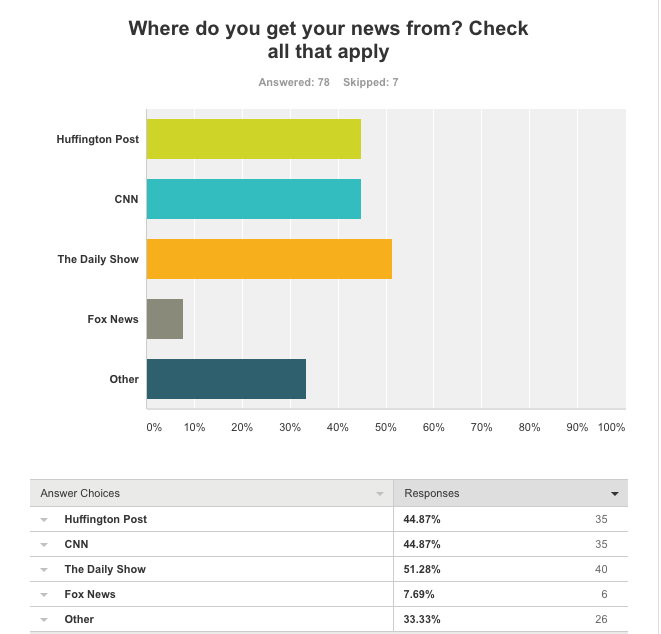As a newspaper, our job is to make sure that our readers get news that they feel is pertinent to their lives. An important part of that is presenting fair and unbiased news. But even that can sometimes be impossible. Despite an article being honest, human writers can, despite their best efforts, put their own biases in an article, and the takeaway of the article is often decided by what facts are included and what facts are left out.
To learn about news bias in our community, the Paper Tiger conducted a survey to learn about where students at Lick-Wilmerding get their news from. Of the 85 answers, 51% said that the Daily Show was a primary source of news. The Huffington Post and CNN were listed by 45% as a primary source of news, and Fox was listed as a primary source for 8% of our respondents. Other answers included Google News, The New York Times, Buzzfeed, Tumblr, NPR, The Colbert Report, and Yahoo.
The overwhelming majority of respondents, who live mostly in San Francisco, listed their main news sources as ones that are considered left leaning, which stands to figure because San Francisco is consistently ranked as the most liberal city in the country.
The 21st century is in an age where news can come from anywhere and anyone. 56% of answerers listed the internet as the main source of their news. Social media was listed as the main source for 24% and word of mouth was 4%, higher than both television and newspapers.
News coming from word of mouth tends to be brought up because someone has a strong opinion on the topic, so these are almost certain to be heavily biased. News on social media is often just as biased as well. One survey answer stated “my friends will post articles on Facebook that they agree with, shaping my opinions to theirs.” For teenagers who have not yet fully experienced the real world, hearing influential figures such as close friends and families offer strong opinions on certain topics is bound to create an atmosphere full of biases and prejudices.
After we asked where Lick Students got their news from, we asked if they felt that there sources of news biased their opinions on social and cultural issues. The answer was an overwhelming yes, with some respondents saying “I feel like they definitely do. The Daily Show is hugely biased, so I try to take it with a large grain of salt” and another saying that the “New York Times is very liberal”. In total, over 90% said that their sources altered their opinions somewhat, with most concluding that it swayed them to the left. Yet despite this awareness of biases, few switch. An interviewee said of noticing bias in a news source: “I think I mostly read it as I would, maybe with a grain or two of salt. Like usually if I’m not going to read it I’m not going to read it anyway.” So, despite being aware of different levels of bias, he would read the same news. Obviously, noticing opinions within news allows one to read the news more objectively, but that’s not always the case.
One answer showed how biases can sometimes go unknown, claiming that if a bias is “more subtle, it’s more likely to influence me.”
It is obvious that many headlines are created to generate buzz and attract lots of viewers. Online this is known as “click bait”. On television it’s known as news. But regardless of a hyperbolic headline or information taken out of context, it’s often clear when something is sensationalist to gain attention. So what about headlines and news reporting that is more subtle? Fox News is notorious for its reputation as a conservative myth monger. One student said that Nancy Grace “brainwashes” those who watch her. Another said that while “Fox gets a lot of bad hype, most other sites” are biased as well.
The biases of reporters inherently influence the views of their readers. Awareness of this fact does sometimes lead to critical reading of that news, it still appears to be something that changes the way news is presented. As long as news exists as a moneymaking corporation, news will be written to sell, not necessarily to report. However, with responsible journalism, careful proofreading, and critical readers, news can again become a source of knowledge, instead of entertainment.





